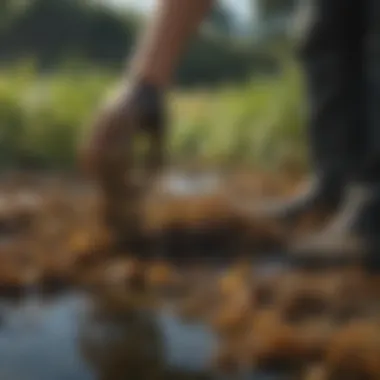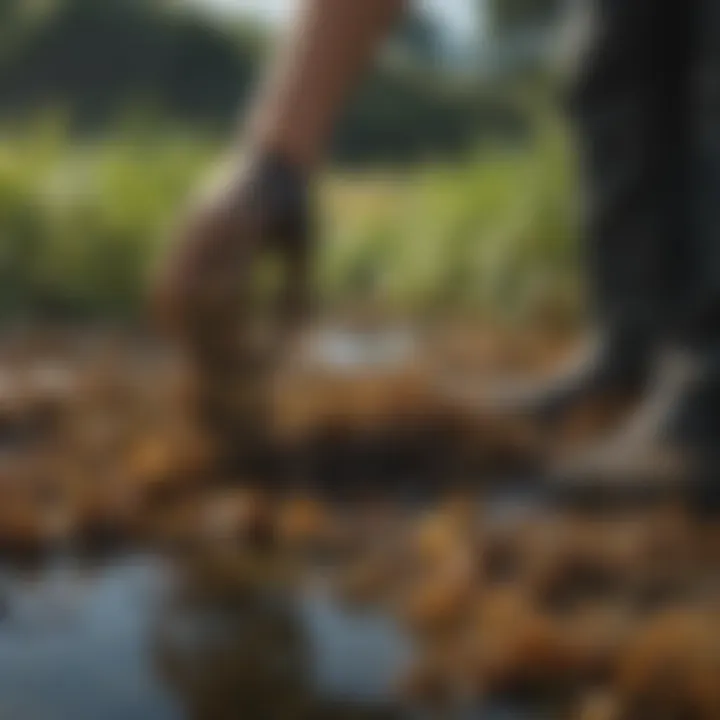Lawn Kelp: Sustainable Lawn Care Insights Uncovered


Intro
Lawn kelp, derived from various species of seaweed, has emerged as a dynamic player in sustainable lawn care practices. The organic matter found in kelp is invaluable for those seeking environmentally friendly alternatives to traditional fertilizers. Its rich biochemical composition offers numerous benefits for soil health and plant vitality. This article provides an in-depth exploration of lawn kelp, examining its chemical makeup, ecological advantages, and its role in promoting sustainable practices in lawn care.
Research Overview
Understanding the role of lawn kelp in sustainable lawn care necessitates a thorough examination of existing research. The integration of kelp into lawn maintenance is supported by various studies emphasizing its potential benefits. The following sections explore methodological approaches, outlining how the efficacy of lawn kelp has been assessed in scientific settings.
Methodological Approaches
Research on lawn kelp typically involves a mix of laboratory studies and field experiments. These methodologies help establish correlations between the application of kelp and improvements in soil fertility and plant growth. Researchers conduct controlled experiments to measure variables such as nutrient content within the soil before and after kelp applications. They also assess plant responses, monitoring factors like growth rates, vigor, and disease resistance.
Significance and Implications
The implications of integrating lawn kelp into care routines are significant. The utilization of kelp as an amendment can lead to healthier ecosystems, enhancing soil structure and increasing the microbial activity within the soil. These changes not only improve nutrient uptake by plants but also contribute to the resilience of lawns against environmental stressors. The findings may also encourage a shift in lawn care practices, steering individuals and organizations toward more sustainable and less chemically reliant methods.
Current Trends in Science
As the field of sustainable horticulture evolves, it is critical to stay updated with current trends in research about lawn kelp.
Innovative Techniques and Tools
Recent advancements in technology have allowed for the exploration of innovative techniques in applying kelp extracts efficiently. Tools such as drip irrigation systems and advanced soil sensors help in optimizing the application of kelp extracts, ensuring that plants receive adequate nutrients without overuse. Researchers are experimenting with liquid kelp fertilizers that allow for quick uptake by plants, maximizing benefits.
Interdisciplinary Connections
The study of lawn kelp does not exist in isolation; it intersects with various fields including ecology, agronomy, and environmental science. Collaborative efforts among these disciplines deepen the understanding of how kelp can contribute to sustainable agriculture. For instance, exploring the role of kelp in coastal ecosystems can inform better practices in lawn care by integrating coastal ecology principles.
"Incorporating kelp into lawn care is not just about improving plant health—it's about fostering a holistic approach to environmental stewardship."
As research continues, lawn kelp stands out not only for its practical benefits in lawn management but also its broader implications in shaping sustainable practices.
Prolusion to Lawn Kelp
Lawn kelp is increasingly recognized for its essential role in sustainable lawn care practices. As the demand for organic solutions rises among both homeowners and landscapers, understanding the benefits and applications of lawn kelp becomes critical. This section sets the foundation by elucidating the nature of kelp and its significance in enhancing lawn health and resilience.
Definition and Overview
Lawn kelp refers to various species of seaweed, primarily from the brown algae family, used as a soil amendment and as a plant growth stimulant. These algae are harvested from coastal waters to be processed into liquid or powdered forms for application in gardens and lawns. Kelp is rich in nutrients, making it an excellent organic option for boosting soil fertility. Its composition includes essential macro and micronutrients that are vital for plant growth.
In addition to nutrients, kelp contains growth hormones, which facilitate processes like root development and stress response in plants. The application of kelp can enhance soil structure and increase water retention, crucial for maintaining healthy plants, especially in arid climates. This makes kelp not just a nutrient source but a holistic approach to lawn care that aligns with eco-friendly practices.
Historical Use of Kelp in Agriculture
The use of kelp in agriculture has a long history, dating back thousands of years. Ancient civilizations recognized the benefits of this marine plant. Farmers in Japan and Ireland have traditionally utilized kelp to improve soil quality and promote crop growth. Kelp was often spread on fields to increase nutrient availability, thus enhancing agricultural productivity.
In modern times, the application of kelp has evolved, shifting from solely agricultural use to lawn care practices. Current research supports its effectiveness not only in crop yield but also in lawn management, providing a natural alternative to synthetic fertilizers. The transition reflects a broader movement towards sustainable agriculture and eco-friendly landscaping, making lawn kelp a pivotal element in contemporary lawn care strategies.
Chemical Composition of Kelp
Understanding the chemical composition of kelp is crucial in grasping its role as an organic soil amendment in sustainable lawn care. Kelp is rich in essential nutrients that contribute to plant health. These nutrients can be categorized into macronutrients, micronutrients, and bioactive compounds. Each of these elements has benefits and specific considerations.
Macronutrients in Kelp
Kelp naturally contains significant quantities of macronutrients, primarily nitrogen, phosphorus, and potassium, often referred to as NPK.
- Nitrogen is vital for plant growth. It aids in the development of leaves and stems, promoting lush, green growth.
- Phosphorus supports root development and plays a role in flower and fruit production.
- Potassium improves overall plant health by enhancing disease resistance and regulating water use.


These macronutrients in kelp function collectively, fostering robust lawn ecosystems and ensuring optimal growth conditions. Their organic nature makes them preferable to synthetic fertilizers, which can lead to chemical imbalances in the soil.
Micronutrients and Trace Elements
Kelp is also an exceptional source of micronutrients and trace elements, including iron, zinc, manganese, and copper. These elements, though required in smaller amounts, are equally essential for a plant’s success.
- Iron promotes chlorophyll production, which is critical for photosynthesis.
- Zinc plays a crucial role in enzyme function and plant metabolism.
- Manganese is important for photosynthesis and nitrogen assimilation.
- Copper is involved in reproductive growth and enzymatic processes.
The presence of these micronutrients can mitigate deficiencies that might hinder plant growth. This diversity signifies the natural balance that kelp provides, ensuring that lawn care is both effective and environmentally sustainable.
Bioactive Compounds and Hormones
Beyond macro- and micronutrients, kelp contains various bioactive compounds and hormones, such as auxins, gibberellins, and cytokinins. These compounds play pivotal roles in plant growth regulation and stress response.
- Auxins regulate plant growth and development, ensuring that plants grow in ways that are beneficial for their health.
- Gibberellins encourage seed germination and stem elongation.
- Cytokinins promote cell division and can help delay aging in plants.
The benefits of these bioactive compounds extend to enhancing overall plant resilience, especially under environmental stress situations like drought or disease.
Kelp’s unique chemical composition underscores its value as a sustainable solution in lawn care, offering a blend of essential nutrients and bioactive compounds suitable for healthy plant development.
The chemical makeup of kelp not only enriches the soil but aligns with the principles of sustainable gardening practices, making it an important component in contemporary lawn care.
Ecological Benefits of Lawn Kelp
Lawn kelp, a natural seaweed product, offers significant ecological benefits that contribute to sustainable lawn care. Its introduction into lawn management practices fosters a more balanced ecosystem both above and below ground. Understanding how kelp supports soil health, enhances microbial life, and impacts environmental sustainability is essential for those interested in eco-friendly gardening and landscaping techniques.
Soil Health Improvement
Kelp positively affects soil structure and fertility in multiple ways. One of the most notable aspects is its ability to increase organic matter content. The natural fibers in kelp improve soil aeration and water retention, essential factors for optimal root development. Well-aerated soil allows air to circulate, encouraging respiration for roots and beneficial microbial life.
Furthermore, kelp contains natural growth hormones, such as auxins and cytokinins, which promote root growth and plant development. Improved root systems facilitate deeper penetration into the soil, enhancing nutrient uptake. This is critical for maintaining healthy grass and plants. The amendments help build a stronger and more resilient lawn, capable of withstanding stressors like drought or pests.
Enhanced Microbial Activity
Another ecological benefit of kelp is its stimulation of microbial activity in the soil. A diverse microbial community is vital for nutrient cycling and overall soil health. When kelp is applied, it introduces various organic compounds that serve as a food source for beneficial microbes. These microbes play a key role in breaking down organic material and making nutrients available to plants.
Additionally, kelp enhances the growth of mycorrhizal fungi, which form symbiotic relationships with plant roots. These fungi increase the area from which plants can absorb water and nutrients. The improved microbial activity leads to a healthier soil ecosystem, which in turn supports more vigorous plant growth. With lively microbial populations, lawns become less susceptible to diseases and weeds.
Environmental Sustainability Impact
The use of lawn kelp aligns with principles of environmental sustainability. By opting for a natural soil amendment like kelp, lawn care practices become less reliant on synthetic fertilizers. This shift reduces potential runoffs that contribute to water pollution in nearby lakes and streams. Natural kelp products break down more slowly than many chemical fertilizers, contributing to gradual nutrient release and minimizing the risk of nutrient leaching.
Moreover, kelp's application contributes to carbon sequestration. Healthy lawns can capture and store carbon dioxide from the atmosphere. By enhancing soil health and promoting plant growth, kelp indirectly contributes to the global effort to combat climate change.
In summary, the ecological benefits of lawn kelp are evident in its ability to improve soil health, enhance microbial activity, and promote sustainability. As lawn management strategies shift towards more environmentally friendly practices, the incorporation of kelp stands out as a viable solution.
Application Methods of Lawn Kelp
The application methods of lawn kelp hold significant importance in harnessing its full potential as an organic soil amendment. Understanding these methods allows both casual gardeners and professionals to maximize the benefits of kelp, ensuring a healthier and more sustainable lawn. This section delves into the various application methods, providing insight into their specific elements, benefits, and considerations.
Liquid Kelp Extracts
Liquid kelp extracts are among the most popular ways to use kelp in lawn care. These products are typically processed to concentrate the beneficial nutrients and compounds found in kelp. The ease of application is a primary advantage; the liquid can be evenly distributed across a lawn using a spray nozzle or a watering can. This method allows for immediate absorption by the grass, making nutrients readily available.
One key benefit of liquid kelp extracts is their ability to enhance soil moisture retention. Studies show that these extracts can improve water infiltration in soil, reducing drought stress on grass. Moreover, they stimulate microbial activity in the soil, further improving its health. It's important to follow the recommended dilution rates. Over-concentration may lead to nutrient runoff, which can be detrimental to local waterways.
Granular Kelp Products
Granular kelp products provide another effective application method. These products are often mixed into the soil or used as a top dressing. Unlike liquid forms, granular kelp breaks down more slowly, releasing nutrients over a longer period. This slow release is beneficial for maintaining nutrient levels in the soil gradually, supporting continued grass growth.


Granular application can be particularly useful in establishing new lawns or enhancing existing ones. To apply, it's typically recommended to use a spreader for an even distribution. This process helps in avoiding clumps that could lead to uneven grass growth. While granular products are generally easy to use, awareness of the specific nutrient content is essential to avoid excessive fertilization, which could lead to nutrient imbalances.
Timing of Application
The timing of kelp application is crucial for optimizing its benefits. Applications can occur during different stages of the lawn's growth cycle, but understanding the ideal windows can make a significant difference. The best times to apply are usually during the early spring and fall when the grass is actively growing.
Applying kelp in the spring sets the stage for enhanced growth during the growing seasons. Conversely, fall applications help to prepare the lawn for winter by building resilience against cold weather effects. Additionally, ensuring the lawn is adequately watered before applying kelp helps improve the absorption of nutrients.
In summary, knowing the most effective methods of applying lawn kelp can greatly influence the outcome of grass health. Top-of-the-line results often stem from blending liquid extracts, granular products, and correct timing. A thoughtful approach ensures a sustainable and lively lawn, showcasing the importance of incorporating kelp into lawn care practices.
Effectiveness of Lawn Kelp
The effectiveness of lawn kelp in promoting grass health cannot be understated. Its unique biochemical properties serve several beneficial roles in lawn care. Lawn kelp is often recognized for its role in improving overall plant vigor, drought resistance, and disease resistance. Each of these facets contributes significantly to the sustainability of lawn care practices.
Growth Promotion in Grasses
Lawn kelp contains a unique array of nutrients essential for plant growth. The presence of both macronutrients and micronutrients can stimulate grass growth effectively. Studies suggest that applying kelp can lead to an increase in root mass, which is crucial for nutrient uptake. More developed roots mean the grass can access more water and nutrients from the soil, which is particularly vital during dry seasons.
Moreover, the bioactive compounds, like cytokinins found in kelp, stimulate cell division, contributing to lush, green blades. This growth promotion makes it an excellent alternative to synthetic fertilizers, providing a more balanced nutritional profile for grass species.
Drought Resistance Enhancement
Drought is a significant concern for lawns, especially in dry climates. Lawn kelp can enhance drought resistance in several ways. First, the application helps improve soil structure, promoting better water retention. This is critical as it enables the lawn to withstand longer periods without significant rain.
Furthermore, the phytohormones present in kelp extracts can enhance stress tolerance in plants. They help stimulate deeper root growth, allowing grasses to access moisture from lower soil layers during dry spells. This resilience is an increasingly necessary characteristic as climate change leads to more frequent and severe droughts.
Disease Resistance Qualities
When it comes to disease resistance, lawn kelp shows promise as well. It increases the plant's natural defenses against pests and pathogens. The presence of certain organic compounds in kelp can trigger the plant's defense mechanisms, making it less susceptible to diseases like brown patch and dollar spot.
In addition to bolstering inherent resistance, improved plant vigor, supported by kelp application, means the grass is more robust overall. Healthier grass is less likely to succumb to disease due to its vigorous growth and better environmental adaptation.
"The potential of lawn kelp in enhancing plant health is clear, as it significantly contributes to growth, drought resilience, and disease resistance."
In summary, the effectiveness of lawn kelp lies in its multifaceted benefits, making it a formidable ally in sustainable lawn care.
Comparative Analysis with Traditional Fertilizers
When discussing lawn care strategies, understanding the differences between lawn kelp and traditional fertilizers becomes essential. Lawn kelp serves as an organic alternative, presenting unique benefits that highlight its role in sustainable lawn management. This section explores three critical areas of comparison: nutrient release mechanism, long-term soil impact, and cost-effectiveness.
Nutrient Release Mechanism
Lawn kelp operates differently compared to traditional fertilizers. Conventional fertilizers often rely on synthetic compounds that provide rapid nutrient delivery. In contrast, kelp is rich in organic matter, which means nutrients are released more gradually. This slow release not only caters to the immediate needs of grass but also minimizes the risk of nutrient leaching. Leaching can occur after heavy rain or irrigation, where excess nutrients wash away, potentially polluting the water systems. The natural nutrient profile of kelp, particularly its high potassium content, gifts it a distinct advantage in nutrient delivery without the environmental harm associated with many synthetic fertilizers.
Long-Term Soil Impact
The long-term impact of using lawn kelp is another aspect that sets it apart. With continued use, kelp enhances soil structure and increases its fertility. Kelp contains polysaccharides that bind soil particles together, promoting aeration and water retention. Traditional fertilizers, in contrast, can lead to soil degradation over time, harming beneficial microorganisms essential for soil health. By improving soil conditions, kelp can contribute to better drought resistance and reduced runoff, presenting a more holistic approach to lawn care compared to traditional methods.
Cost-Effectiveness Assessment
Cost is always a crucial factor in decision-making. While traditional fertilizers may appear more affordable at first glance due to lower upfront costs, a deeper examination reveals the long-term savings associated with kelp. Its ability to enhance soil health results in reduced needs for chemical inputs over time. Furthermore, healthier soil translates to enhanced lawn resilience, reducing the frequency of expensive repairs and reseeding. In terms of environmental cost, kelp's sustainable profile can lead to fewer regulatory burdens and potential fines related to water pollution.
"Comparative analysis of lawn kelp and traditional fertilizers reveals that while traditional options may provide quick results, kelp's gradual nutrient release and long-term benefits reshape sustainable lawn care."
In summary, a thoughtful comparison of lawn kelp with traditional fertilizers underscores its value in sustainable practices. As the trends in horticulture evolve toward environmentally friendly solutions, lawn kelp could become a leading option for lawn enthusiasts seeking both effective and responsible methods.
Potential Drawbacks and Limitations
In discussions surrounding lawn kelp, it is vital to address not only its benefits but also the potential drawbacks and limitations. While kelp serves as a valuable organic soil amendment in sustainable lawn care, it may come with certain challenges that users should consider when incorporating it into their practices. An informed approach helps ensure that the anticipated advantages are met without unintended consequences.


Possible Nutrient Imbalances
One of the primary concerns when using lawn kelp is the potential for nutrient imbalances in the soil. Kelp naturally contains a variety of essential nutrients. However, when applied in excessive amounts, it can lead to situations where certain nutrients are present in high concentrations, while others may become deficient. This imbalance can hinder optimal plant growth and health.
To mitigate this issue, it is important for gardeners to perform soil tests before application. Understanding the existing nutrient levels will help tailor the amount of kelp needed. Regular monitoring of plant health will also assist in identifying any deficiencies early.
Variability in Product Quality
Another limitation of lawn kelp is the variability in product quality available on the market. Different manufacturers may use varying extraction methods or sources of kelp, affecting the nutrient content. Consequently, not all kelp products are equal. Subpar quality products may not provide the desired results or may even harm the plants over time.
When selecting kelp products, consumers should prioritize reputable brands known for their consistent quality. Reading reviews and checking for certifications helps ensure that products meet industry standards and expectations for effectiveness.
Environmental Considerations
Lastly, while lawn kelp is considered an environmentally friendly option, its harvesting can have significant environmental impacts if not managed sustainably. Kelp farming is often seen as a beneficial practice, but irresponsible practices can lead to habitat destruction. Moreover, the use of harvested kelp should be balanced with its growth rate in the marine ecosystem to prevent depletion.
To address these concerns, consumers can choose products sourced from sustainable fisheries or farms. Supporting responsible kelp farming initiatives not only ensures product quality but also promotes ecological balance in coastal areas.
"Understanding the potential drawbacks of using kelp is essential for maximizing its benefits in sustainable lawn care."
Future Directions for Research
Research on lawn kelp is still evolving, and there are many potential directions for future investigations. This section aims to explore the possibilities to strengthen the role of kelp in sustainable lawn care.
Innovative Uses in Urban Agriculture
Urban agriculture is gaining traction as cities seek to enhance food production sustainably. Lawn kelp could have numerous applications in this context. Its rich nutrient profile can be particularly beneficial for urban farming environments that often lack natural nutrients. Kelp extracts can improve soil moisture retention, which is crucial in densely populated areas where water resources are limited. Thus, research can investigate how kelp interacts with urban farming techniques.
Furthermore, studies may explore how kelp can support the growth of vegetables and fruits in vertical gardens, rooftop farms, and community gardening projects. Testing different applications of kelp in these settings provides insights into their efficiency and overall impact on urban yield.
Integration with Other Organic Practices
Integrating lawn kelp with other organic practices could enhance soil health and crop yields. Researching how kelp can be combined with composting, cover cropping, or crop rotation may yield valuable synergies. For instance, the interaction of kelp with compost could accelerate the availability of nutrients, making them more accessible for plant uptake.
Exploring companion planting with kelp as a soil amendment is another potential area of study. Identifying which plants thrive alongside kelp amendments could lead to more efficient organic farming systems. Understanding the relationships among different organic practices will help develop holistic approaches to sustainable agriculture.
Longitudinal Studies on Efficacy
The long-term efficacy of lawn kelp as a soil amendment is yet to be fully understood. Longitudinal studies will be crucial in revealing how kelp affects soil health and plant growth over multiple growing seasons. These studies can analyze not just immediate effects but also how continuous use impacts soil structure, microbial diversity, and nutrient availability.
Additionally, research should consider the economic aspects of using kelp in lawn care. By evaluating the cost-to-benefit ratio over several years, stakeholders can better understand whether kelp provides sustainable value compared to traditional fertilizers.
Therefore, comprehensive studies can lead to recommendations that will benefit the landscape industry and those involved in agricultural practices.
Understanding these aspects will refine the application of lawn kelp and make it a cornerstone in sustainable agriculture.
Epilogue
The conclusion serves as a vital synthesis of the ideas presented throughout this article. It encapsulates the significance of using lawn kelp in sustainable lawn care practices and highlights critical elements regarding its benefits and application. This section reminds the audience about the versatile role that kelp plays, not just as a nutrient source but also as an enhancer of ecological balance in the lawn ecosystem.
Summary of Key Benefits
Lawn kelp comes with numerous advantages that contribute to sustainable landscaping. Some of the primary benefits include:
- Nutrient-Rich Composition: It contains essential macronutrients and micronutrients that promote healthy grass growth.
- Soil Health Enhancement: Kelp acts as a natural biostimulant, improving soil texture and structure while promoting beneficial microbial activity.
- Drought Resilience: The application of kelp can enhance a lawn's ability to withstand periods of low water availability.
- Environmental Impact: By relying on an organic amendment, users support eco-friendly practices, reducing reliance on synthetic fertilizers that may harm soil health and local ecosystems.
Overall, these benefits underline the case for including lawn kelp in one's lawn care regimen.
Recommendations for Use
To maximize the benefits of lawn kelp, consider the following guidelines:
- Application Timing: Apply kelp during the growing season, ideally in early spring or early fall, when grass roots are actively taking up nutrients.
- Mixing with Other Organic Materials: Combining lawn kelp with compost can further enhance its effectiveness, providing a more nutrient-dense amendment.
- Regular Maintenance: Incorporate kelp into your maintenance routine, applying it at regular intervals to ensure continuous soil health benefits.
- Monitor Soil Health: Conduct soil testing periodically to understand the nutrient profile and adjust the application accordingly.
By adhering to these recommendations, users can leverage the full potential of lawn kelp to foster a thriving and sustainable lawn.



